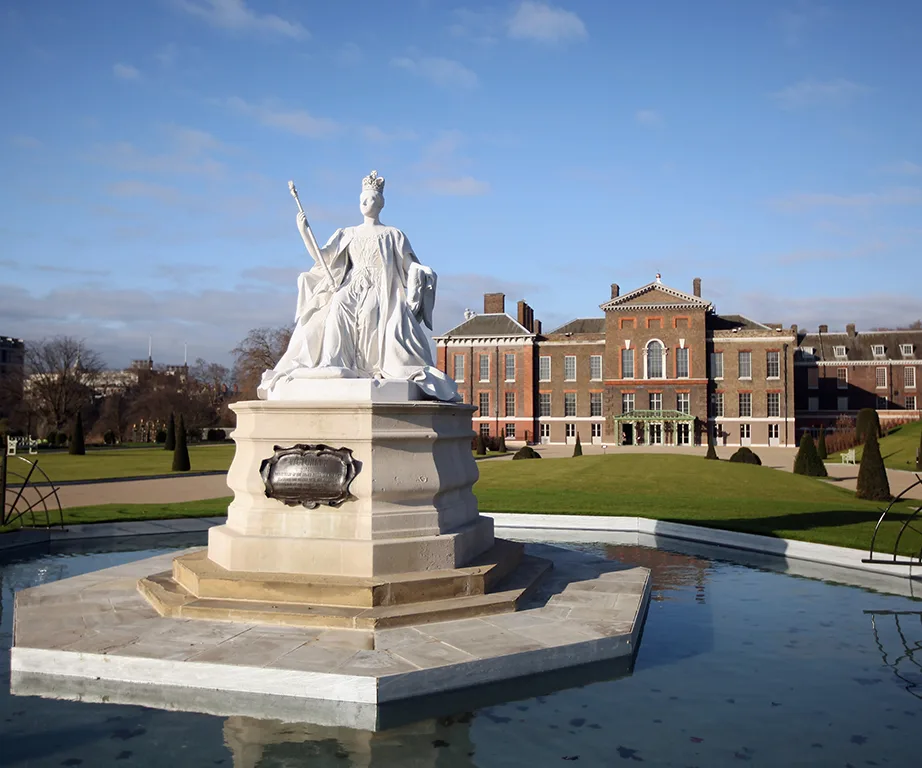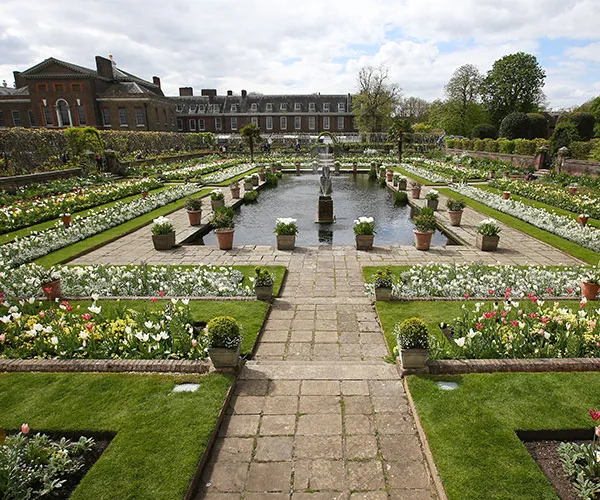Queen Victoria, Princess Margaret and Princess Diana have all called Kensington Palace home and it’s currently the official residence of Duke and Duchess of Cambridge as well as Harry and Meghan.
But what do we actually know about this fancy London residence? Here are the facts about one of the most talked about royal homes in the world.
It’s been in the British Royal Family since the late 17th century
Bought by royalty in 1689 for $35,000 (equivalent of today’s $2.4 million), Kensington Palace was cherished as both a country-style bolthole and a fabulous place to party in the centre of London. The property was nestled in the rarified air of clean, green Kensington village, west of London.
It was newly crowned William III and Queen Mary II who were house- hunting when they espied the palace, then known as Nottingham House, a Jacobean manor originally built in 1605, which they recognised as the perfect antidote to King William’s chronic asthma. They had spurned the principle royal home, Whitehall Palace, because its city location in the smog of Westminster and proximity to the River Thames was detrimental to the King’s health.
It’s all about the new
From its earliest days as a royal residence, Kensington Palace was home to forward-looking monarchs, keen to embrace new design styles and champion young artists. Queen Mary indulged her passion for the novel Chinese and Japanese porcelain that was flooding into the country from the Orient, and filled the elegant palace with luxury pieces.
Between 1691 and 1694, William and Mary threw 14 lavish balls, with up to 1000 guests feasting and drinking, and the King gambling until 5am. In 1693, he lost the “princely” sum of 200 Guineas ($28,000 in today’s money) at a high-risk gaming table!
On Christmas Eve 1694, 32-year-old Queen Mary spotted the fatal mark of smallpox on her arm and died four days later. Distraught widower William died eight years later in a riding fall at Hampton Court Palace.
Queen Anne is responsible for a lot of the decor
The next monarch to flex her artistic designs on the palace was Mary’s sister, Anne, and her husband, Prince George of Denmark. The much-copied “Queen Anne Style” of architecture and design began here with a “Green House” to show off her beloved exotic plants.
Anne favoured the elaborate designs of Sir John Vanbrugh over those of the more traditional Sir Christopher Wren, who built St Paul’s Cathderal. When, in 1717, King George I ordered Vanbrugh to go full-steam ahead on extensive rebuilding of the palace, it would keep him busy for 10 years.
Echoing the choice of Vanbrugh over Wren, new boy William Kent stole the commission to decorate the state apartments from official royal designer James Thornhill in 1722. His flamboyant decor still draws gasps today, including the ceiling of the Privy Chamber, which he adorned with Mars, the god of War, and Minerva, the goddess of Wisdom.
Queen Victoria was born here and called it home until she became queen

Today, there’s a statue of Queen Victoria in the Kensington Palace grounds.
In 1761, King George III decided he preferred other royal residences to Kensington Palace and started a new trend. Instead of living there, he offered its rooms to other members of the royal family and courtiers. (A century later, Edward VIII drolly referred to the palace as the “aunt heap”.)
Soon after 1798, George III’s son, Edward, Duke of Kent, took up residence in the sovereign’s former private apartments and it was in these rooms that his daughter, Princess Victoria, was born on May 24, 1819. In fact, she spent the next 18 years of her life here, before ascending the throne.
On the death of Victoria’s uncle, George IV, in 1830, another uncle, William IV, was crowned King and the young Princess became next in line to the throne.
Her mother, the Duchess of Kent, and the Duchess’ ambitious adviser, Sir John Conroy, sought to protect and enhance their power by keeping Victoria under their control.
Their rigid set of rules, which became known as the “Kensington System”, haunted the future Queen. As a Princess, Victoria was never allowed out of the sight of an adult and was rarely given permission to play with other children. She even had to sleep in the same room as her mother, until she became Queen. Victoria later recalled that she “led a very unhappy life as a child”.
On June 20, 1837, Princess Victoria, at the age of 18, became Queen of a vast empire when her Uncle William died. On leaving Kensington Palace, which she missed, she never shared a bedroom with her mother again. The new Queen took up residence at Buckingham Palace – the first monarch to do so. Sir John Conroy, who had hoped to become Victoria’s private secretary, was promptly dismissed.
You can buy a house there, but it will cost you
In the 1840s, the Crown Estate developed Kensington Palace’s original market gardens with a row of private houses, known as Kensington Palace Gardens, which became one of London’s most desirable addresses. Known as “Billionaire’s Row”, they are still some of the most expensive properties anywhere in the UK, with an average house worth around $62 million.
Just think, your neighbours could be royalty!
It’s fallen on hard times over the years
By 1897, Kensington Palace had seen better days and a campaign to save it gathered pace. London-based The Graphic magazine, focusing on the palace’s artistic heritage, wrote, “Surely something ought to be done to rescue this old palace from ruin?” Queen Victoria herself agreed and lent her voice to the appeal, helping persuade Parliament to pay for the restoration of the state apartments, so they could be opened to the public.
World War I closed the palace doors to the public in 1914 and, during the 1940 London Blitz, the palace was badly bombed.
Princess Margaret had some wild times there

We can only imagine the parties Princess Margaret must have hosted!
Princess Margaret, perhaps the resident who has become most closely associated with Kensington Palace, lived there for nearly 42 years.
After World War II, restoration on the damaged parts of the palace started, but in 1961, when Princess Margaret told her sister, the Queen, that she was pregnant, the work began in earnest.
Apartment No 1A, the property which was earmarked for the Snowdons, took 18 months to renovate. In the meantime, the Princess and her husband moved into No 10, a more modest property, always intended as a stop-gap. No 1A offered twice as much space. The term “apartment” is misleading, as the property is a four- storey, 20-room building.
The couple moved into its generous interiors in 1963 and the new cool royal residents’ swinging parties became famous. Guests included ’60s stars, such as dancers Rudolph Nureyev and Margot Fonteyn, hairdresser Vidal Sassoon, Peter Sellers, Elizabeth Taylor and Mary Quant.
Lord Snowdon’s uncle, Oliver Messel, a celebrated theatrical set designer, gave advice and the apartment incorporated the best of old and new. The drawing room became the showpiece, with a Regency-style look – draped curtains and neatly paired Georgian gilded mirrors, which were all the rage in ’60s London.
Although the couple divorced in 1978, Princess Margaret lived at Kensington Palace until her death in 2002.
It’s now a family home
.jpg?resize=1024%2C853)
Not a bad first home for George, Charlotte and Louis!
In the early ’80s, No 8 and No 9 were joined to form the marital home of the then Prince and Princess of Wales.
Princes William and Harry are said to be excited to be returning to the palace where they grew up as children.
After their 2011 wedding, the Duke and Duchess of Cambridge were granted a cottage in the grounds of the palace. They lived in Nottingham Cottage, a comparatively modest two-bedroom property, for two years while renovations took place on Princess Margaret’s famed No 1A apartment. The improvements were closely overseen by Catherine and the remodelling has reportedly taken inspiration from Crown Princess Mary of Denmark’s Copenhagen home, the Amalienborg Palace. “Mary showed them around their home and they loved the way they [Mary and her husband Crown Prince Frederik] had combined their collection of modern art with antique furniture,” reported London’s Daily Express. “Kate was truly inspired and wants to use some similar ideas in the rooms at Kensington Palace.”
Prince William, Catherine and baby Prince George moved into their renovated palace home back in October 2013, just in time for George’s christening. With Prince Harry and Meghan in nearby Nottingham Cottage, which William and Catherine had occupied previously, the family are close together.
As boys, William and Harry often took walks in the palace gardens with their mother. They were also within walking distance of their prep school, which little Prince George attends as well. Prince William’s in-laws, Carole and Michael Middleton, are said to be making occasional use of guest bedrooms at the palace when they stay over, while the palace’s current permanent royal residents include the Duke and Duchess of Gloucester and Prince and Princess Michael of Kent.
Its legacy lives on

The White Garden was installed in memory of the late Princess Diana who spent many years at Kensington Palace.
When Diana died in 1997, the forecourt of Kensington Palace became a shrine and a focal point for public mourning. The palace stayed open for 24 hours as 136,000 mourners signed the condolence books. Diana had lived at the palace for almost 13 years, much of the time with her two sons.
More than 300 years after its construction, Kensington Palace is still in the family – providing country-style living in the heart of London – and with occasional champagne corks popping, it seems little has changed since the 17th century.


